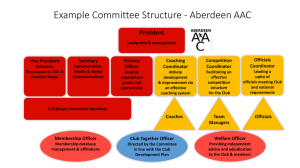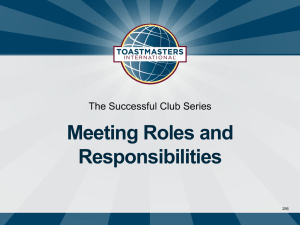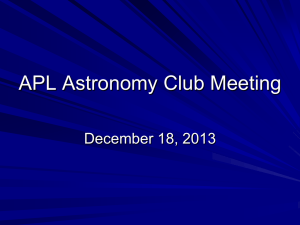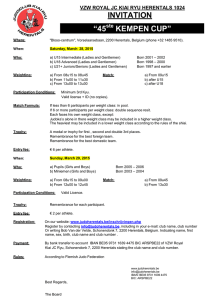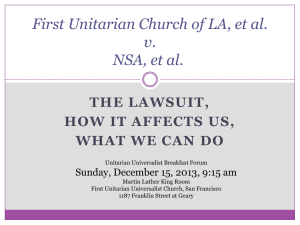Code-Breaking and the Beginning of Computers
advertisement
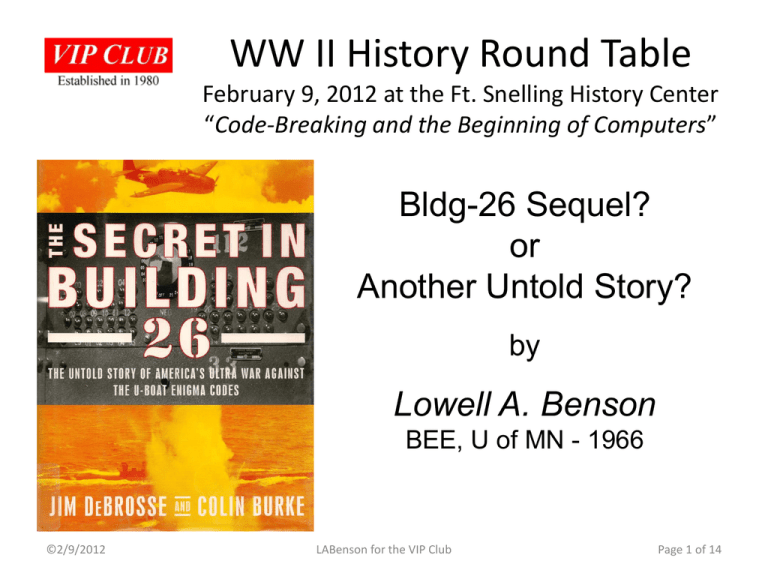
WW II History Round Table February 9, 2012 at the Ft. Snelling History Center “Code-Breaking and the Beginning of Computers” Bldg-26 Sequel? or Another Untold Story? by Lowell A. Benson BEE, U of MN - 1966 ©2/9/2012 LABenson for the VIP Club Page 1 of 14 Sequel? – The Place, the People • As WW II ended, the Navy, concerned that the makeup of the CSAW* team be preserved in peacetime, offered civil service appointments to several members including Howard Engstrom and William Norris – Engstrom suggested that they form a private company. • They were joined by a new partner, Capt. Ralph I. Meader, who had had headed the Naval Computing Machine Laboratory (NCML) which manufactured ‘bombe’ devices for CSAW at NCR in Dayton, Ohio. • The result was Engineering Research Associates (ERA) located in an old glider factory in St. Paul, MN – financing partially from John Parker. *Communications Supplementary Activities, Washington ©2/9/2012 LABenson for the VIP Club Page 2 of 14 Code-Breaking and the Beginning of Computers Reference: Department of Defense history: History of NSA [National Security Agency] General-Purpose Electronic Digital Computers, Samuel S. Snyder, 1964 - Originally released under NSA FOIA 41023, 2/9/2004 - Requested and re-released under Mandatory Declassification Review in June 2009 “For the 15 years beginning about 1935, NSA's predecessors used punched-card equipment to attack wider and wider ranges of problems. During this time many special-purpose machines were also built, including some designed as attachments to punched-card equipment. The use of punched card equipments as general-purpose tools continued to grow until, by the end of World War II, 750 machines had been installed.” ©2/9/2012 LABenson for the VIP Club Page 3 of 14 More NSA Report Quotes • Punched-card equipment -- keypunch, reproducer, sorter, collator, and tabulator -- were the forerunners of the electronic computer in every respect excepting speed and automatic operation. This is true because of the use of the punched-card as a unit record, flexibility of plug board together with switching capabilities in each machine, and versatility inherent in successive card passes through different equipments. The following types of data analyses could be done using punched-card equipments: expanding, reproducing (Reproducer) - distributing, sorting (Sorter) - merging, selecting (Collator) - counting, printing (Tabulator) • In addition to operating an extensive computer installation, NSA has been a prime sponsor of computer developments. Of the nine electronic computer projects discussed in the following sections, two, ABNER and CUB, were designed and built by NSA (or predecessor) personnel. The rest were built under contract, following logical designs conceived or inspired by NSA personnel. ATLAS I, ABNER, BAKER, NOMAD, BOGART, SOLO, CUB, ATLAS II, and UNIVAC 1224A (CRISPI). ©2/9/2012 LABenson for the VIP Club Page 4 of 14 Telling the Other Story In 2005 the VIP Club & co-sponsor Lockheed Martin began an IT Legacy Committee – collecting artifacts and documenting the our Legacy as a web site anthology; over 250 ex-employees have contributed career summaries and/or project/product stories A 66-year LEGACY of Defense Industry Information Technology (IT) developments and applications started in 1946 with Engineering Research Associates (ERA) at 1902 Minnehaha Avenue in St. Paul, Minnesota. This Information Age Legacy merged and diverged through the corporate ownerships of Remington Rand, UNIVAC, Sperry, UNISYS, PARAMAX, Loral, and Lockheed Martin. Lockheed Martin MS2 in Eagan, Minnesota triggered the end of this defense industry IT Legacy with their November 2010 announcement that the Eagan facility will close in 2013. ©2/9/2012 LABenson for the VIP Club Page 5 of 14 Telling the Story - 1986 • Sperry published a 1986 booklet in commemoration of ERA’s 40th anniversary – Engineering Research Associates - The wellspring of Minnesota’s computer industry • Several people mentioned in Colin Burke’s book are part of the ERA story. [Engstrom, Norris, Meader, Welchman, Eachus, … ] • “The company hired nearly 40 more CSAW staffers as well as several veterans of the Naval Ordnance Laboratory and the Office of Naval Research and moved them to the NAC plant in St. Paul.” ©2/9/2012 LABenson for the VIP Club Page 6 of 14 Telling the Story - 1986 • At a 1947 symposium, Dr. Arnold Cohen introduced two terms that would become commonplace in the computer industry: volatility and non-volatility. • ERA began development of non-volatile magnetic drum memories – information remained intact whether power source is on or off. • ERA magnetic drums were utilized in two special purpose calculating machines, code named Goldberg and Demon, delivered to CSAW in 1948. • The Navy’s confidence was rewarded. The ATLAS I computer … was delivered to Washington, D.C. in October 1950. “It’s my belief that Atlas I was the first American stored-program electronic computer to be delivered – delivered in finished, working condition,” observes Cohen. ©2/9/2012 LABenson for the VIP Club The ‘Goldberg’ Drum prototype is in the Minnesota Historical Society Museum Page 7 of 14 Will We Ever Know? An early Sperry Computer Genealogy Chart showed some ERA Classified Systems: •A 1959 Remington Rand UNIVAC products book lists the Demon, Hecate, and O’Malley as “special purpose computing system that was designed and built for the U.S. Navy. Its specifications are classified.” •That 1959 book lists: “Robin I and II are specialpurpose, analytical computers designed for military purposes. All information is classified.” •The 1959 book lists ATLAS, Goldberg, NTDS*, and Warlock as having classified applications. •Also, a dozen ‘classified’ peripheral and sensor devices are listed for Navy, Air Force, and Army applications. • “Blind Man's Bluff" by Sherry Sontag and Christopher Drew revealed the CIA tapping of communication lines underwater between Kamchatka and Vladivostok , they used a UNIVAC 1124 computer in a submarine - not in any of our product books. *Naval Tactical Data Systems ©2/9/2012 LABenson for the VIP Club Page 8 of 14 Telling the Story - 1987 ERA is more than a history footnote! 1. David Lundstrom’s 1987 career history book chronicles the Control Data Corporation (CDC) beginning 2. The CDC founder, William ‘Bill’ Norris, was one of the ERA founders and a Bldg 26 projects veteran. 3. This time-line chart lists but a third of Minnesota companies which can trace their lineage back to ERA. 4. CDC became the best known Minnesota computer company, Cray Research is also a spinoff (1972.) 5. The impact of all of these companies to Minnesota’s economy is into the billions of $s since the late ‘40s. ©2/9/2012 LABenson for the VIP Club 9 of 14 Telling the Story - 1999 Capt. David Boslaugh - US Navy, ret., told parts of the ERA story. Chapter 3 is “The Codebreaking Computers – A Digital Solution” “The reason for heightened Navy interest in radio message cryptanalysis, compared to the Army program, could be explained by greater reliance of land armies on telegraph and telephone wire communications whereas if forces afloat wanted to communicate ‘instantaneously’ over long distances, radio was their only option. Accordingly, during the 20 years between 1921 and 1941 the Navy spent three to five times as much on radio intercept and codebreaking activities as did the Army, ….” ©2/9/2012 LABenson for the VIP Club Page 10 of 14 Telling the Story - 2009 Dr. Tom Misa began his 2009/10 “Minnesota’s Hidden History In Computing” lecture series with the history of ERA. The Question? “Who invented the computer?” An enigma or who did what first; i.e. 1st commercial computer, 1st stored-program computer, 1st delivered computer, 1st transistorized computer, 1st integrated circuit computer, …, etc. Wikipedia and the web have many ‘opinions’, some without citing a confirmed source of the stated ‘fact.’ ©2/9/2012 LABenson for the VIP Club Page 11 of 14 Telling the Story - 2012 There are many, many chapters in the Other Story! •Air Traffic Control Systems •Airline Reservation Systems •Carrier Landing Systems •Catalogue Ordering Systems •Command & Control Systems •Fiber Optic Communications •Global Positioning Systems •Missile Launch Systems •NATO & SEATO Systems •Satellite Launching Systems •Space junk Tracking Systems •Submarine Tracking Systems •Telemetry Process Systems •Voice Recognition Systems ©2/9/2012 LABenson for the VIP Club 12 of 14 Thanks for Inviting Our Participation The VIP CLUB was created in 1980 as the Sperry Retirees Club - a non-profit, social and service organization. Today, we are over 1,000 retirees and former employees from UNISYS, Lockheed Martin MS2 and the Twin Cities 'heritage’ companies as illustrated in this IT Legacy icon. Lowell A. Benson – BEE, U of MN, 1966 • VIP Club President 2011, VP 10/09, Treasurer 08/07, Director ‘06, Associate ’05 • IT Legacy Committee co-chair since October 2005 • U of MN Center for Transportation Studies, 1994-2001 (Engineering Manager) • UNIVAC 1960 (file clerk) => UNISYS 1994 (Senior Staff Systems Engineer) • Engineering Consultant ‘Gigs’, 1985 => 2009 • Selective Service Board (standby), St. Paul, 1981 – 2001 • 328th MI detachment (reserves) at Ft. Snelling, 9/60 – 3/63 • US Army Security Agency at Monterrey, CA & Germany, 7/57 – 6/60 • MN National Guard at Minneapolis Armory, 9/56 – 6/57 Reference Sources • NSA document re-print available on our web site, http://vipclubmn.org/Documents/NSA-HGPEDC_1964.pdf • A Few Good Men from UNIVAC – public library • When Computer’s Went to Sea - IEEE or public library • Sperry’s 40th ERA anniversary booklet – reprint copies here • Univac Products Book, 1947 to 1959 – will be at the Charles Babbage Institute • Minnesota’s Hidden History in Computing, http://www.cbi.umn.edu/resources/MHHC/index .html - Dr. Tom Misa holds the ERA Land Grant Chair in the History of Technology • Our Club and IT Legacy web site – http://vipclubmn.org ©2/9/2012 LABenson for the VIP Club Page 14 of 14

